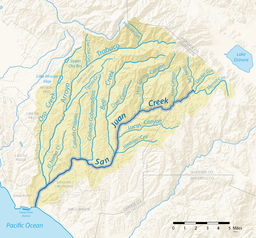San Juan Creek
| San Juan Creek | |
| San Juan River | |
|
Hikers ford San Juan Creek below the hot springs, February 2008.
|
|
| Name origin: Named for Mission San Juan Capistrano by Spanish conquistadors in the 1700s. | |
| Country | United States |
|---|---|
| State | California |
| Regions | Orange County, Riverside County |
| Tributaries | |
| - left | Lucas Canyon Creek, Verdugo Canyon Creek, Trampas Canyon Creek |
| - right | Lion Canyon Creek, Hot Springs Canyon Creek, Cold Spring Canyon Creek, Bell Canyon Creek, Cañada Gobernadora, Cañada Chiquita, Horno Creek, Trabuco Creek |
| Source | head of San Juan Canyon, at the confluence of Morrell Canyon Creek with Bear Canyon Creek, Santa Ana Mountains |
| - elevation | 1,690 ft (515 m) |
| - coordinates | 33°36′49″N 117°26′07″W / 33.61361°N 117.43528°W |
| Mouth | San Juan Lagoon, Doheny State Beach, Dana Point |
| - elevation | 0 ft (0 m) |
| - coordinates | 33°27′42″N 117°41′01″W / 33.46167°N 117.68361°WCoordinates: 33°27′42″N 117°41′01″W / 33.46167°N 117.68361°W |
| Length | 29 mi (47 km) |
| Basin | 133.9 sq mi (347 km2) |
| Discharge | for San Juan Capistrano |
| - average | 26.1 cu ft/s (1 m3/s) |
| - max | 14,700 cu ft/s (416 m3/s) |
| - min | 0 cu ft/s (0 m3/s) |
|
Map of the San Juan Creek watershed
|
|
San Juan Creek, also called the San Juan River, is a 29-mile (47 km) long stream in Orange County, California draining a watershed of 133.9 square miles (347 km2). Its mainstem begins in the southern Santa Ana Mountains in the Cleveland National Forest. It winds west and south through San Juan Canyon, and is joined by Trabuco Creek as it passes through San Juan Capistrano. It flows into the Pacific Ocean at Doheny State Beach. San Juan Canyon provides a major part of the route for California State Route 74 (the Ortega Highway).
Before Spanish colonization in the 1770s, the San Juan Creek watershed was inhabited by the Acjachemen or Juañeno Native Americans. The Juañeno were named by Spanish missionaries who built Mission San Juan Capistrano on the banks of a stream they named San Juan Creek. The watershed was used mainly for agriculture and ranching until the 1950s when residential suburban development began on a large scale. Since then, the human population has continued to encroach on floodplains of local streams. Flooding in the 20th and 21st centuries has caused considerable property damage in the San Juan watershed.
The San Juan watershed is home to sixteen major native plant communities and hundreds of animal species. However, the watershed is projected to be 48 percent urbanized by 2050. In addition, urban runoff has changed flow patterns in San Juan Creek and introduced pollutants to the river system. Although the main stem of San Juan Creek does not have any major water diversions or dams, some of its tributaries, including Trabuco and Oso Creeks, have been channelized or otherwise heavily modified by urbanization.
San Juan Creek begins high in the Santa Ana Mountains southwest of Lake Elsinore, at the head of the steep and narrow San Juan Canyon, at roughly 1,678 feet (511 m) in elevation where Morrell Canyon Creek, draining the western Elsinore Mountains and southernmost Santa Ana Mountains, has its confluence with Bear Canyon Creek. From there, it flows steeply down a rocky gorge over rapids and waterfalls. San Juan Canyon forms the mountain pass for California State Route 74 (the Ortega Highway), which connects San Juan Capistrano to Lake Elsinore and the Inland Empire. San Juan Falls, a 15-foot (4.6 m) cascade, and the 30-foot (9.1 m) Ortega Falls are located along the headwaters of the creek. The creek then flows generally southwest through a canyon, receiving Hot Springs Creek and Cold Springs Creek from the right, and Lucas Canyon Creek from the left.
...
Wikipedia


